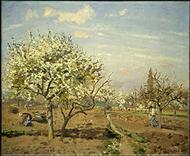
|
Camille Pissarro (artist) French, 1830 - 1903 Orchard in Bloom, Louveciennes, 1872 oil on canvas Overall: 45.1 x 54.9 cm (17 3/4 x 21 5/8 in.) framed: 70.8 x 80.6 x 5.7 cm (27 7/8 x 31 3/4 x 2 1/4 in.) Ailsa Mellon Bruce Collection 1970.17.51 |
Camille Pissarro, one of the creators of the impressionist style, was the only impressionist to participate in each of the eight group exhibitions. He sent five paintings to the first show in 1874. Its modest scale and simple subject notwithstanding, Orchard in Bloom, Louveciennes headed the list of Pissarro's works in the catalogue, perhaps for personal associations. Fleeing with his family to London during the Franco-Prussian War, the artist waited until late 1871, after the suppression of the Commune, to return to his home in Louveciennes. His house had been occupied and many of the paintings he had left behind had been destroyed. As France began to rebuild, the artist also gradually recovered from the disaster. In Orchard in Bloom, Louveciennes, painted the next spring, abundant white blossoms and freshly plowed soil are tokens of hope and renewal.
Early in his career Pissarro designated himself a pupil of Corot, and in this 1872 painting Pissarro's broad method of composing and choice of a tranquil rural setting inhabited by a few small peasant figures still recall the older artist. Pissarro was able to sell the painting in July 1872, soon after its completion. It was bought by a new and important patron, Paul Durand-Ruel, one of the earliest impressionist purchases by the dealer remembered for his courageous and sustained support of the avant-garde artists.
From the Tour: The Beginnings of Impressionist LandscapeWhen the idea arose for a group exhibition of work by the artists who would come to be called impressionists, Pissarro and Sisley were among the earliest and most enthusiastic supporters. Pissarro drafted the group's written statement of purpose and would be the only artist to participate in all eight impressionist exhibitions. This painting was one of five he showed at the first exhibition in 1874.
It was made shortly after Pissarro had returned to his home in Louveciennes after fleeing France during the Franco-Prussian War and Paris Commune. (Born in the Virgin Islands, then a possession of Denmark, Pissarro was a Danish citizen.) During the war his house had been used by Prussian troops, and many of the canvases he left there were destroyed. He must have viewed the freshly plowed earth, like the spring blossoms that bring life to the dormant landscape, as a signal of renewed hope for his adopted country and for his career. Pissarro's work was then beginning to attract buyers. This painting, for example, was one of the first impressionist works purchased by Paul Durand-Ruel, a dealer whose support was to become critical to the young artists.


